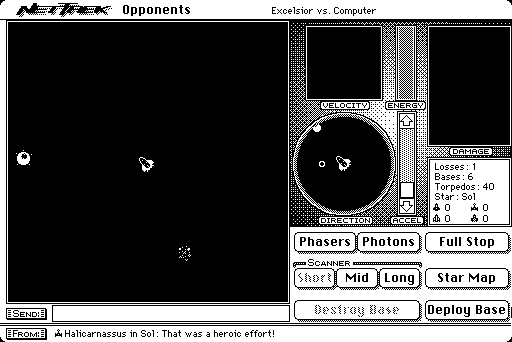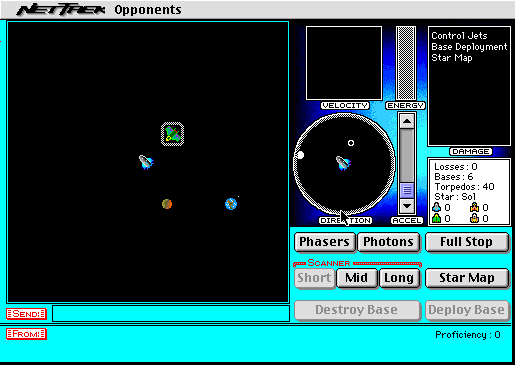|
|
written by Randy Carr |
|
NetTrek - Where'd it come from and where'd it go?
Way back in 1982, before Warp-Drive, there was this secret new computer being developed
at Apple Computer known as the 'Lisa'.
The Lisa computer had a real bitmapped screen that was fairly large (i.e. lots of pixels!) and a real pointing device that resembled what Xerox had done in the late '70's, known as the 'mouse'. I was working at Apple Computer in those days, so I was privy to details about this computer. The first time I saw a Lisa, I knew it was time for NetTrek. I had seen a similar game on the Xerox Alto II computers several years earlier known as Trek. Of course, I wasn't thinking of calling it NetTrek, rather something like of a MacTrek or MTrek. Oh how those names were SO geeky! The name NetTrek came later... I tried to get the first version of NetTrek done for the Lisa computer, but there was this even newer computer in the 'pipe' that was much more affordable and even faster. This was the Macintosh. It didn't really start out as affordable, but it was cool. The major problem was that you still needed a Lisa to program anything for the Mac. So, after putting off a major roof replacement on my house and I got my own Lisa for doing that NetTrek thing for the Mac. In those days, a Lisa could cost as much as $10,000 and that was in 1984 dollars. The first version of NetTrek for the Macintosh was written about 95% in assembly language as I was originally an assembly programmer for the Apple II, so assembly language was fine with me. Bit by bit more of the programming was added in Pascal (there wasn't any C compilers until later; besides the ROM routines in the Mac were written with the Pascal compiler in mind). Since the first versions of NetTrek ran only as a multi-player game, I needed other people to test it with me. As it's really hard to handle 3 or 4 computer mice at the same time. Some late night I panicked a bit about the game getting released without my knowledge, so I inserted a shareware message into one of the 'Info Screens', just in case one of my trusty testers thought that it was OK to send it to their friends. Of course, this is exactly what happened and NetTrek became a shareware game. Really, I never intended on selling NetTrek, or even doing shareware. I just wanted people to play the game... By about 1985 or early 1986, there was another Macintosh (aka Milwaukee) in the works at Apple that had a color display rather than just a black & white display. Wow, color, on a Mac? Cool. Oh, but that meant that I needed to program new code to draw to the color bitmapped display. OK, start over. After many hours of trying to write quick code that would draw to the display, I determined that the routines in the Macintosh ROM were actually faster than anything I came up with (I got 'smart' later). In 1987, the Macintosh II was released and the same time version 2.5 of NetTrek was finished. I don't think anyone has a copy (other than myself) of that crummy version as it was the direct grand-daddy of the last formal existing version known as NetTrek- the Real Version (version 3.0). For some unknown reason, I decided to obey the advice with my friends and 'ship' NetTrek as a commercial (purchasable) version with a [now] defunct company, Premier Technology. Did I make lots of money? Nope. I never really received any of the money they collected by selling this version. But now, so many years later, maybe it's time to resurrect and revive NetTrek for those players who want it again.
Luckily we live in such a social world now as someone posted on YouTube a short video of the original
"shareware" version of the app, mostly written in 68000 assembly. Here's NetTrek 1.0, circa 1985+: 
And some kind soul made a video of that original game running on an early 80's Macintosh. This version shown below is version 1.0 and wasn't supposed to be released at all (multiplayer only too).
Which transitioned into "NetTrek - the Real Version": 
|
|
|
If you're interested in chatting about the new NetTrek for MacOS X and iPhone OS or even about the old code that was in the old version, send me: MAIL. |
|